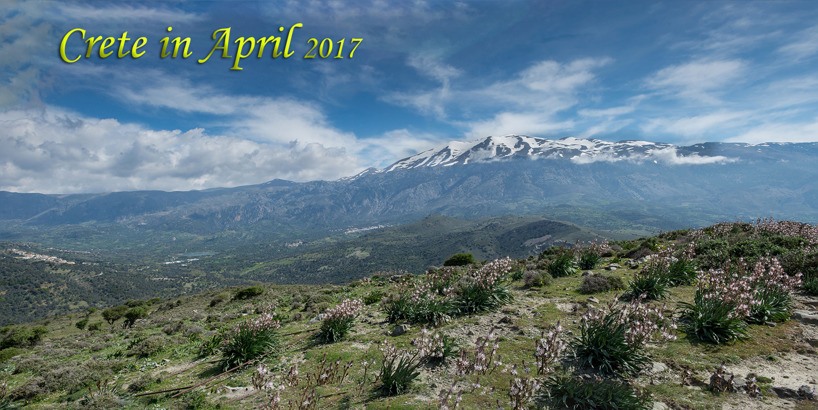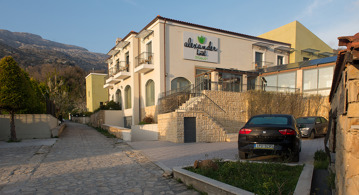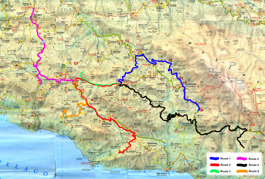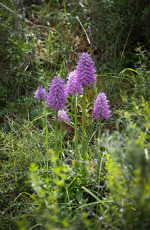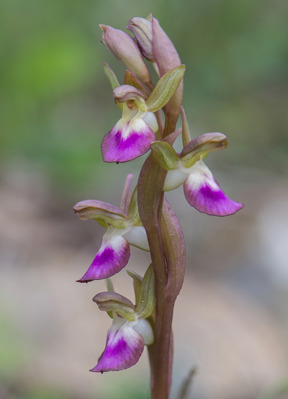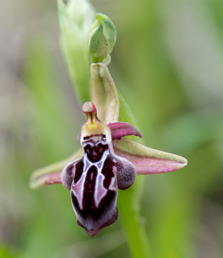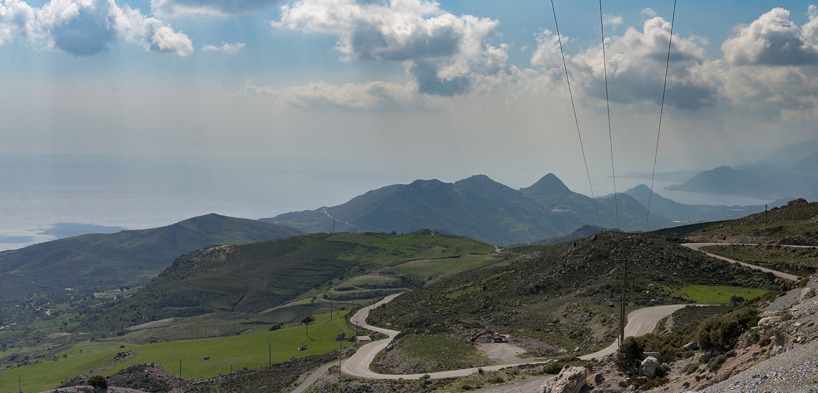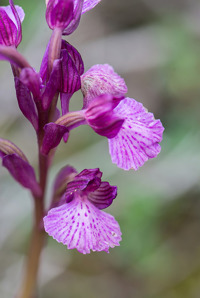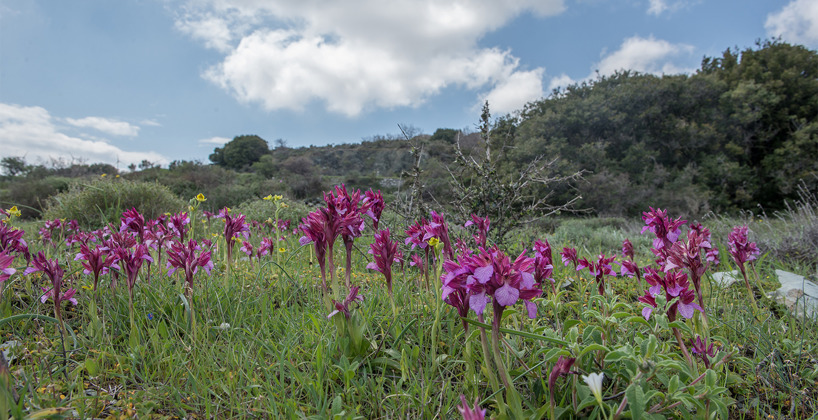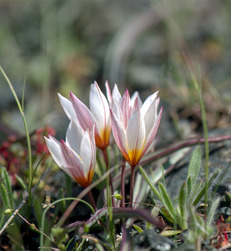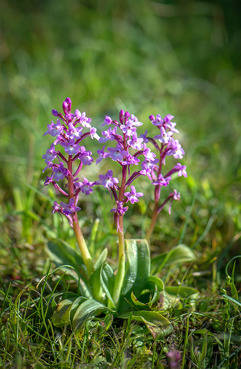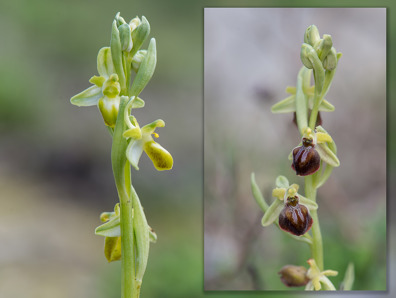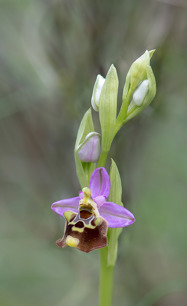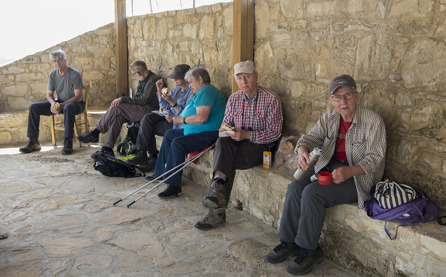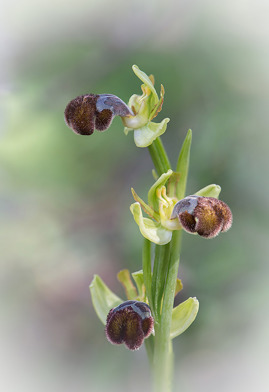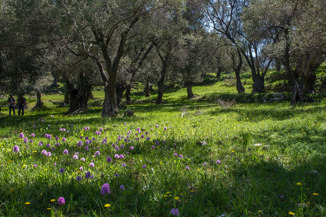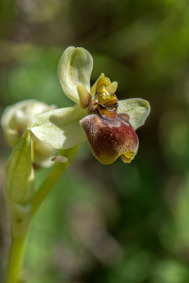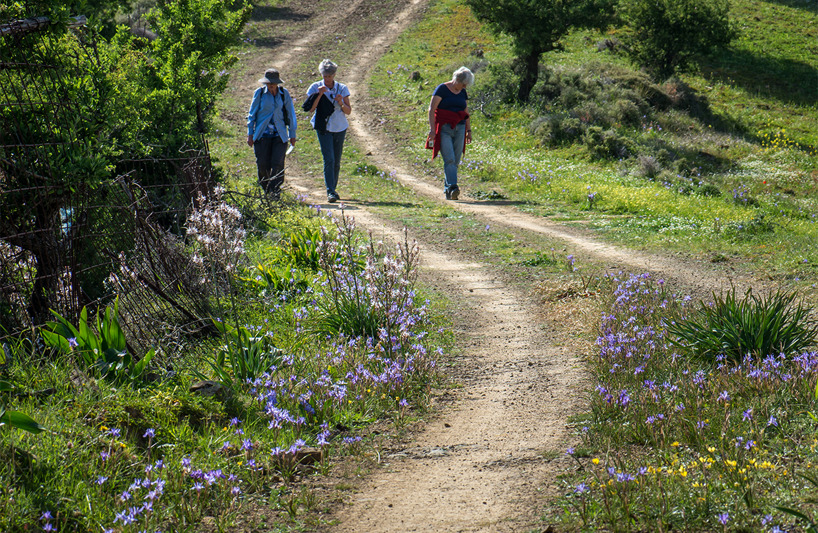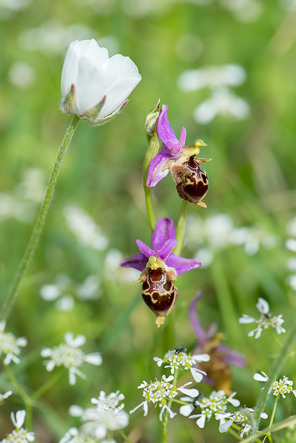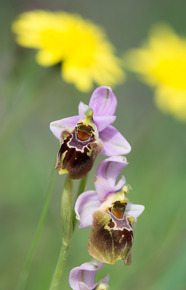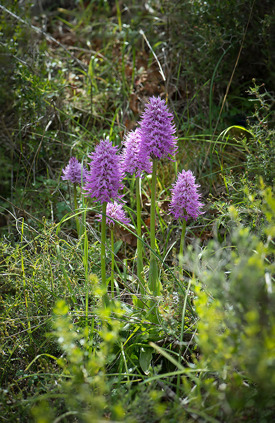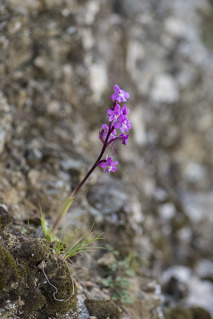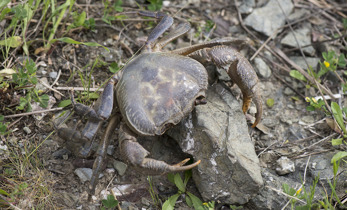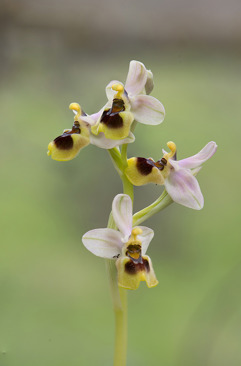Home | Orchid sites | Galleries | Comments | Search
Crete 2017
4-11 April (Please click on the pictures for a bigger version)
During the autumn of 2016, we decided to visit Crete next spring. Six excursions were then planned during the winter, one for each day we had at Crete. Now the time had come to test these in real life. In the end, we became 17 people who met at Kastrup on April 4th to start our week with a direct flight to Chania. The trip back was planned to April 11th. Since our flight home departured late, we also had almost an extra 7th day to do something. Even the flight to Chania started late so before we got our luggage, picked up the cars and then drove about one and a half hours to the hotel, it was almost midnight at our arrival. However, the hotel staff knew about this and was well prepared. The check-in went fast and we could crawl in bed for a night's sleep before next day's excursion.
Our visit was planned for the middle part of the island, the Rethymnon region, and in order to minimize the car driving we had chosen a base half way from the north coast to the south coast, Alexander Hotel in the small village of Gera-kari. The hotel had a nice standard and the group members were really satisfied with this choice. In order to avoid buying food for lunch, we had previously made up with the hotel that they would offer a "lunch basket" for those who wanted this. A service that all of the group members used and what meant that each person was given a bag containing sandwiches, fruit, a juice package and a small bottle of water, full enough to serve as lunch in the fields. Because there were kettles in the rooms, there was no problem getting the thermos filled either
Excursions map
 View eastward from one of the hillocks between Spili and Gerakari.Tulipa saxatilis in the foreground
View eastward from one of the hillocks between Spili and Gerakari.Tulipa saxatilis in the foreground
Weather and season
According to the hotel staff, we were lucky with the weather. The week before, besides being cool, it had been a lot of rain and windy too. Now we could enjoy a week in nice spring weather, about 13-20 degrees depending on the height and time of day, only partly cloudy and not much wind either.
As regards the vegetation it seemed to be in a quite normal mode, neither early nor late. Regarding the orchids, we found most of what we expected. However, we did not succeed with some species, but it may be due to the time of our visit, April 4-11 is quite early in a normal year like this. But instead we got to see something else, such as Tulipa saxatilis and Tulipa cretica. In total we found 39 species / subspecies as well as some color variants and hybrids.
 In spite of all fences we sometimes encountered herding sheep. Here with the mountain Ida in the background
In spite of all fences we sometimes encountered herding sheep. Here with the mountain Ida in the background
Problems
Although we saw some shepherds herding their sheeps, it is clear that they now are fencing the pastures. The most common type of fence used was like a kind of "rebar". In any case, it looked like the thinner rebar used for reinforcement in concrete. The fence becomes very rigid and, if there are no openings, or was openable, it was impossible to get over. Therefore, we had to leave some of the sites we had planned to visit. Some of the notes, used for the planning, were quite old and changes in the fields had made some sites unsuitable for orchids. But most of the sites still gave ample reward.
Expectations
In general, the impression was that this was a very good orchid year and many species were seen in large quantities. The most common were Anacamptis collina, Ophrys sicula and Orchis italica. These were almost seen on all sites. Also Orchis papilionacea subsp. alibertis was common but often in slightly faded condition. Neotinea lactea was also often seen, in lower areas completely faded while in higher-lying sites it was in good condition. Species we expected to see but which we did not find were eg. Neotinea maculata (quite rare in Crete), Anacamptis coriophora subsp. fragrans, it is flowering little later. By Ophrys we had hoped to find Ophrys candica. It was also in flowering, we were told by others who found it, but it is unusual in this part of Crete, so maybe it wasn't that strange that we missed it. Others we expected to find were species of the O. mammosa group but none of these was seen in addition to O. sphegodes subsp. cretensis that may be counted to that group.
Excursions
Below is a brief description of our six excursions and what we found. We had chosen base for our week centrally in the area we intended to investigate, which meant we could minimize driving times and instead get more time out in the fields. Therefore, the average driving distance was not more than about 60 km per day. The roads are generally good with asphalt, albeit narrow and somewhat curved, sometime very curved due to the hilly terrain. Only at a few places we got into gravel roads to get as close to the current site as possible.
The route number below refers to the six routes that were planned during the winter
Wednesday 5 April 2017
Route 4: Toward Rethymnon, Koxare – Armeni about 65 km
Due to the late arrival the night before we had chosen to start somewhat later this morning, but soon after ten o'clock we were on our way.
For this, our first excursion day, we had chosen route 4 as this, of the six routes, was the one that went on at lowest level (300-400 m-level). We assumed that the orchids had come longest here if the time for our week was little too early. This turned out later to be no problem. The route went the same way north as we had arrived in the darkness the night before, northwards towards Rethymnon, but ended, before we arrived that far in an archaeological area just north of Armeni. Before that, we also had a couple of shorter detours from the main road.
Route 4 Site 1
After passing Spili and turning right into the main road to Rethymnon we followed this, about 6 km, to the junction where a road leads to Plakias. About 3 km into this, after passing the village of Koxare, we had site 1 which consisted of slopes with phrygana to the right of the road. Very orchid rich area. Already here we encountered the new type of fence that was impossible to get through.
Species found:
Anacamptis collina
Anacamptis coriophora subsp. fragrans, bud
Anacamptis papilionacea subsp. alibertis
Anacamptis papilionacea subsp. heroica
Himantoglossum robertianum
Ophrys cinereophila
Ophrys cretica subsp. cretica
Ophrys phryganae
Ophrys sicula
Ophrys sphegodes subsp. cretensis
Ophrys tenthredinifera subsp. dictynnae
Orchis italica
Serapias bergonii
Serapias lingua
Serapias parviflora
Route 4 Site 2
Site 2 was a few slopes about 5-600 m into the road after turning left to Rodakino / Chora Sfakion. It turned out, however, that people were building houses nearby, so we did not want to enter the area. We therefor turned back to the main road again and for further transportation to the next site.
Route 4 Site 3
About 1.5 km further on we could park near a gravel road that turned to the right. This was site 3. But before we explored the slopes below the road we decided that it was time for our lunchbaskets from the hotel. Pleased with the lunch and some coffee, everyone was in a hurry to search the site, which consisted of slopes that leaned down from the road towards a pond further down. Here in the humid parts we found Anacamptis laxiflora.
Species found:
Anacamptis laxiflora Ophrys sicula
Anacamptis papilionacea subsp. alibertis Orchis anthropophora
Himantoglossum robertianum Orchis italica
Neotinea lactea Orchis italica var. alba
Ophrys cretica subsp. cretica Serapias lingua
Ophrys heldreichii
Route 4 Site 4
After about 5 km from the previous site, we reached site 4. The site meant some slopes behind an old workshop site, opposite a Shell gas station to the right of the road. But once again we encountered the fence and this time we found no way to get past. We therefore chose to continue to today's fifth and last site.
Route 4 Site 5
Today's last stop was about 4.5 km further ahead of Shell Gas Station. Before that we had passed the village of Armeni and arrived on a road to the left with the sign "Late Minoan Cemetery of Armeni". Here we botanized in the area around the fenced archeological site. It turned out to be a very rich area with, among other things, very much Ophrys cretica subsp. cretica. Especially interesting was the meadow to the left of the fenced area.
Species found:
Anacamptis collina Ophrys sicula
Anacamptis laxiflora Ophrys spruneri subsp. spruneri
Anacamptis papilionacea subsp. alibertis Ophrys tenthredinifera subsp. dictynnae
Himantoglossum robertianum Ophrys tenthredinifera subsp. dimidiata
Ophrys bombyliflora Orchis italica
Ophrys cretica subsp. ariadnae Orchis simia
Ophrys cretica subsp. cretica Serapias bergonii
Ophrys heldreichii Serapias lingua
The time went on and it was time for home travel. This went the same way as we came during the day.
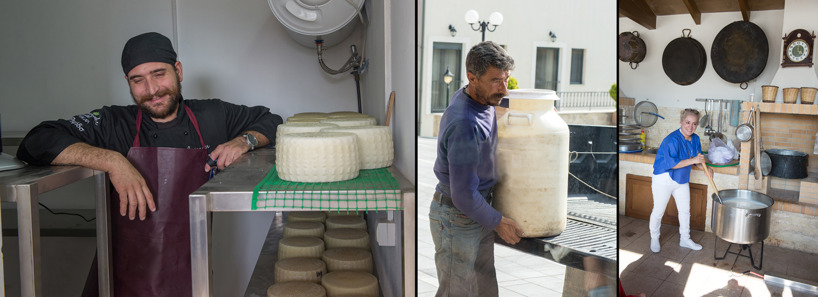 Our nice chef from the hotel demonstrated his way of making cheese. In the middle: The sheep farmers who delivered milk from his sheep. Right: Fariba may try to stir in the milk during warming.
Our nice chef from the hotel demonstrated his way of making cheese. In the middle: The sheep farmers who delivered milk from his sheep. Right: Fariba may try to stir in the milk during warming.
Also this day we came away a little later than usual. However, not because of nightly trips this time but because our hotel chef invited us to see how he made cheese of sheep's milk. After having tasted his products (very good) we got a review of how the process worked before the farmer arrived with the milk. About 60 liters of milk, from about 100 sheep, would give about 10 kg of cooked cheese. Because the process would take another two or three hours before it was cheese we chose to say thank for the demonstration and made us ready for the day's excursion.
Route 6: Spili – Kissou Kambos - Kerames about 50 km
If Wednesday's route went north, it was now time to set the course south. We passed again Spili but now we turned south and followed the road, signposted towards Agia Galini, to the village of Kissou Kambos. Here there was a road to the southwest signposted to Kerames. Most of the day we would botanize along this road. However, we had a couple of sites shortly after passing Spili where site 2 proved impossible to reach in a reasonable way. We therefore left this and continued to site 3.
The southern side of Crete lays in rain shadow. This is also clearly visible looking at the vegetation here. Essentially, it consists of low thorny bushes and herbs usually with bare soil between, because all that grows up is grazed by sheep and goats. However, where these haven't been (or haven't been there yet), there are plenty of orchid species. The route's last site was between Drimiskos and Kerames.
Route 6 Site 1
Today's first site was only a few kilometers after that we passed Spili. Here we went right and drove about 4-500 m on a road that went towards Mourne. Then left onto a narrow dirt road. The site was a hill next to a quarry. It turned out that the hill was inside a now known fence type. However, the most vigilant of us managed to get over and searched the steep slope.
Species found:
Anacamptis boryi
Anacamptis boryi x papilionacea
Anacamptis papilionacea subsp. alibertis
Neotinea lactea
Ophrys cretica subsp. cretica
Ophrys sphegodes subsp. cretensis
Ophrys tenthredinifera subsp. dictynnae
Orchis italica
Orchis pauciflora
Route 6 Site 2
As mentioned above, we left site 2 because the gravel road towards this did not seem safe for our cars. We therefore continued our journey south.
Route 6 Site 3
At the small village of Kissou Kambos we turned right towards Kerames. After about 1.3 km of winding roads, we were at site 3, which consisted of flat areas with scattered shrubs. Orchid rich. Here we also met one of Crete's orchid authorities, Antonis Alibertis, known for a number of books about Greece's orchids. Some of the group members were able to complete their orchid literature because Alibertis had plenty of his books in the car's trunk.
Species found:
Anacamptis boryi Orchis anatolica subsp. anatolica?
Anacamptis collina Orchis anatolica subsp. sitiaca
Anacamptis papilionacea subsp. alibertis Orchis italica
Anacamptis papilionacea subsp. heroica Orchis pauciflora
Himantoglossum robertianum Orchis quadripunctata
Ophrys sicula Orchis simia
Ophrys tenthredinifera subsp. dictynnae
Route 6 Site 4
We continued the same road and rounded the village Aktounta before the road turned south. After 2.6 km from site 3 we reached the small village of Vatos. Just at the entrance there was a narrow road to the right which we followed and after about 500 m we could park at a gravel road to the left. The area consisted of rocky phrygana. In addition to orchids, there were large amounts of Iris cretensis and Iris tuberosa.
Species found:
Anacamptis boryi Ophrys cretica subsp. cretica
Anacamptis papilionacea subsp. alibertis Ophrys heldreichii
Himantoglossum robertianum Ophrys sphegodes subsp. cretensis
Neotinea lactea Orchis anatolica subsp. sitiaca
Ophrys bombyliflora Orchis italica
Route 6 Site 5
Back on the main road again we continued and passed the outskirts of Vatos but after about 200 m we turned right and through a lot of curves we raised about 300 m. Here we had site 5. To the right of the road there were the usual fences that were not possible to get over. On the left side there was an area between the road and the next fence. Here in the almost black gravel, a lot of Tulipa cretica grew, usually not more than 5-10 cm high tulips, endemic to Crete.
Species found:
Anacamptis papilionacea subsp. alibertis
Himantoglossum robertianum
Ophrys cretica subsp. cretica
Ophrys sicula
Orchis pauciflora
Route 6 Site 6
Now we were up and got very magnificent views across the south coast, so a photo stop was necessary before continuing to site 6. This site was on a hill to the right of the road about 1.5 km from previous stop. We parked on a large gravel ground below the top and walked uphill in a rather difficult terrain, steep and rocky but many orchids.
Species found:
Anacamptis boryi
Anacamptis collina
Anacamptis papilionacea subsp. alibertis
Neotinea lactea
Ophrys bombyliflora
Ophrys creberrima
Ophrys cretica subsp. ariadnae
Ophrys cretica subsp. cretica
Ophrys fusca subsp. cressa
Ophrys fusca subsp. creticola
Ophrys iricolor subsp. iricolor
Ophrys sicula
Ophrys sphegodes subsp. cretensis
Ophrys spruneri
Ophrys tenthredinifera subsp. dictynnae
Orchis anthropophora
Orchis italica
Orchis quadripunctata
Serapias bergonii
Serapias parviflora
Route 6 Site 7
Further forward about 4 km we had the last site for the day. Slopes with short vegetation to the left of the road. No news here and it was also time to turn home again so the visit became quite short.
Species found:
Anacamptis collina
Anacamptis pyramidalis
Ophrys bombyliflora
Ophrys heldreichii
Orchis italica
We choose the same route back to the hotel as we had come during the day.
Route 3: Gerakari - Spili about 22 km
Now it was time to visit "The Hillock". This hill, mentioned by many visitors to Crete as special orchid rich, is located east of Spili heading towards Gerakari. Large parts of the area between Spili and Gerakari are interesting fields from an orchid point of view. It was also this area we would search during the day.
This route was the shortest of the planned, only about 11 km one way. We therefore had quite a lot of time to botanize in these orchid-rich fields.
Since we the day before saw that there were a lot of people at the hillock at site 4, we decided to start with this site. Then we drove the remaining part of the 11 kilometers, starting with the point that was furthest away and which was site 1 according to our planned route. We followed the road toward Spili for about 8 km and there, in a sharp left curve, we headed towards Patsos. The first site was about 1.8 km into this road. Here it turned out to be impossible to get over the fence. The area also looked havely grazed. So we turned and drove back, via site 2, to the Spili-road. Even site 3 in our route was well closed with fence so even this we left without any search.
Since we already checked site 4 we now drove to site 5 which lay along a gravel road that took off to the right about 500 m beyond site 4. The area concerned is the area between the two small chapels lying here.
We also continued another 900m ahead along the gravel road to check.
We ended the day with site 6 which was shortly after that we got back to Spili-road. From here we had no more than about 5 km back to the hotel.
Route 3 Site 4
We chose to start the day at site 4 in case there would appear too many orchid hunters. This hillock is known for its orchid wealth. About 6 km from the hotel, at the road to Spili, there is a house at the right side and a sign "TAVERNA Kampos". The hillock is just to the left of the road. There was a brook between the road and the hill, but a fallen tree worked excellent as a bridge over this. One of our cars left off just before we arrived and followed a bad dirt road behind the hill to avoid the problem with the brook. Here on the south side of the hill there were large amounts of Tulipa saxatilis. Now, some had begun fade but an impressive sight in any case.
Species found:
Anacamptis boryi Ophrys heldreichii
Himantoglossum robertianum Ophrys iricolor subsp. iricolor
Neotinea lactea Ophrys sicula
Neotinea tridentata Ophrys sphegodes subsp. cretensis
Ophrys bombyliflora Orchis anthropophora
Ophrys creberrima Orchis italica
Ophrys cretica subsp. cretica Orchis pauciflora
Ophrys cretica subsp. ariadnae Orchis quadripunctata
Route 3 Site 1
Now we proceeded to site 1. About 8 km from the hotel in a left curve, a road left to the right towards Patsos. We followed this for about 1.8 km to a gravel road that left down the slope to the left. The area now seemed to be heavily grazed and also impossible to reach due to high fence. We therefore turned and drove to the next site. However, some species were seen along the roadside.
Species found:
Himantoglossum robertianum Ophrys tenthredinifera subsp. dictynnae
Ophrys bombyliflora Orchis italica
Ophrys sicula Orchis pauciflora
Ophrys sphegodes subsp. cretensis Orchis quadripunctata
Route 3 Site 2
The site was no more than 400 m further on. Here there was a slightly broader roadside to the right where it was possible to park. The site was the rocky (phrygana) slopes ahead to the right of the road.
Species found:
Anacamptis boryi Ophrys sphegodes subsp. cretensis
Anacamptis papilionacea subsp. alibertis Ophrys tenthredinifera subsp. dictynnae
Himantoglossum robertianum Orchis anthropophora
Neotinea lactea Orchis italica
Ophrys sicula Orchis pauciflora
Route 3 Site 3
Same as at site 1 there were fences without openings. The area also looked quite heavily grazed and with only thorny shrubs. So we proceeded without making any attempt to enter.
Route 3 Site 5
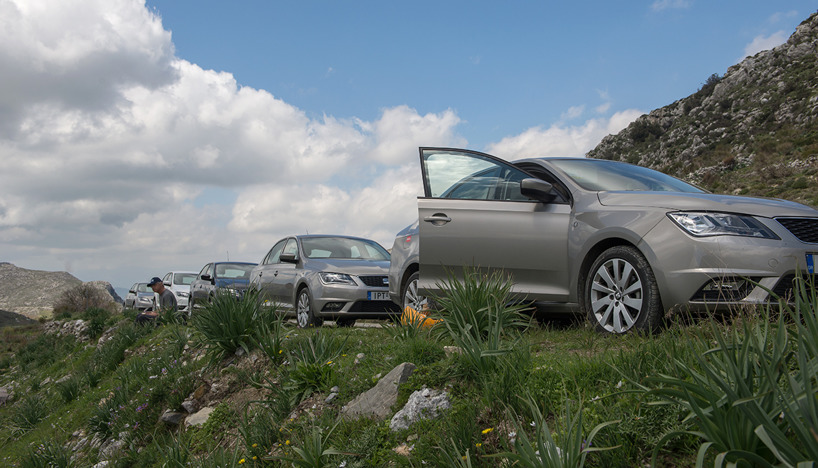 The cars are important on such a journey. There will be a number of hours in these during the week so spacious cars are preferred. This time it turned out we were upgraded to a bigger car than booked.
The cars are important on such a journey. There will be a number of hours in these during the week so spacious cars are preferred. This time it turned out we were upgraded to a bigger car than booked.
Since we already had visited site 4 earlier in the morning we past this now and continued about 500m towards the 5th. Here a few hundred meters into a gravel road at a small chapel we had our lunch before we searched the site.
Species found:
Anacamptis boryi Ophrys fusca subsp. creberrima
Anacamptis laxiflora Ophrys heldreichii
Anacamptis papilionacea subsp. alibertis Ophrys sicula
Himantoglossum robertianum Orchis anthropophora
Neotinea lactea Orchis italica
Ophrys bombyliflora Orchis quadripunctata
Ophrys cinereophila
We also continued about 900m ahead at the gravel road to look up the slopes further on. Many orchids, but no news.
Route 3 Site 6
We turned and continued on the Gerakari road but after about 100m there was a graveled area on the left side where we could park while we searched site 6, the slopes below the road. Very rich area.
Species found:
Anacamptis collina
Himantoglossum robertianum
Neotinea lactea
Neotinea lactea var. alba
Neotinea tridentata
Ophrys creberrima
Ophrys cretica subsp. ariadnae
Ophrys heldreichii
Ophrys sicula
Ophrys sphegodes subsp. cretensis
Ophrys sphegodes subsp. cretensis alba-form
Ophrys omegaifera subsp omegaifera
Ophrys spruneri subsp. spruneri Orchis italica
Ophrys tenthredinifera subsp. dictynnae Orchis pauciflora
Orchis anthropophora Orchis quadripunctata
Since it began to be late afternoon, we chose to drop the route's site 7 and instead drive back to the hotel.
Griffon vulture we saw almost daily. This day we had as many as 11 at the same time circling in the air above us.
Route 5: Gerakari – Grigoria about 97 km
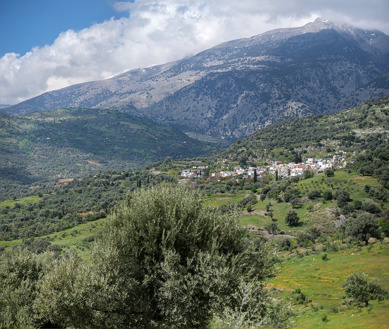 Today's ultimate destination, the village of Grigoria is beautifully situated on the slopes below the mountain Ida.
Today's ultimate destination, the village of Grigoria is beautifully situated on the slopes below the mountain Ida.
This time we almost drove down to the south coast. We drove most of the day at the levels 300-400 m, with site 1 at about 550 m and last site at Grigoria at about 400 m. The route went largely through pastures and cultivated fields where such was possible. Although that we didn't drive at real high hights, we almost all time drove at narrow, winding roads.
From Gerakari we drove east and the first site was already after about 2 km. Then the journey went south-east through a number of small villages. It started with Kardaki then came Vrises, Drigies, Ano Meros, Hordaki, Agios Ioannis and onwards we passed Nithafri, Apodpoulou, Vathiako, Platanos, Ardaktos, Lochria, Kamares and finally Grigoria. None of these caused problems, many we were out from almost before we noticed that we run into. Just after Grigoria we left to the right and then again to the right. Here in slopes was the place for this day's last site, the site with the unusual but very big-grown Ophrys spruneri subsp. grigoriana.
The trip back to the hotel went through Agia Galini and from there the Rethymnon-road to Spili where we turned towards Gerakari. A good hour's drive.
Route 5 Site 1
Today's first stop was once again a miss. Within the fence the terrain was heavily grazed by sheep or goats. So even though it was possible to get through here, there was not much to see besides the beautiful stone church we parked at.
Species found:
Ophrys sicula
Ophrys tenthredinifera subsp. dictynnae
Route 5 Site 2
We therefore proceeded forward and passed the first two villages, Kardaki and Vrises. Shortly after Vrises there was a small church and here we had site 2. The site was the area around and behind the chapel and beyond, along the road where we just arrived. Open fields and phrygana. Even here there was a fence that we couldn't pass by. But an area behind the chapel lay outside and here in the bushy environment there were a lot of species.
Species found:
Anacamptis boryi Ophrys cretica subsp. cretica
Anacamptis papilionacea subsp. alibertis Ophrys episcopalis
Himantoglossum robertianum Ophrys heldreichii
Neotinea lactea Ophrys sicula
Neotinea tridentata Orchis anatolica subsp. sitiaca
Ophrys cinereophila Orchis italica
Ophrys creberrima Orchis quadripunctata
Route 5 Site 3
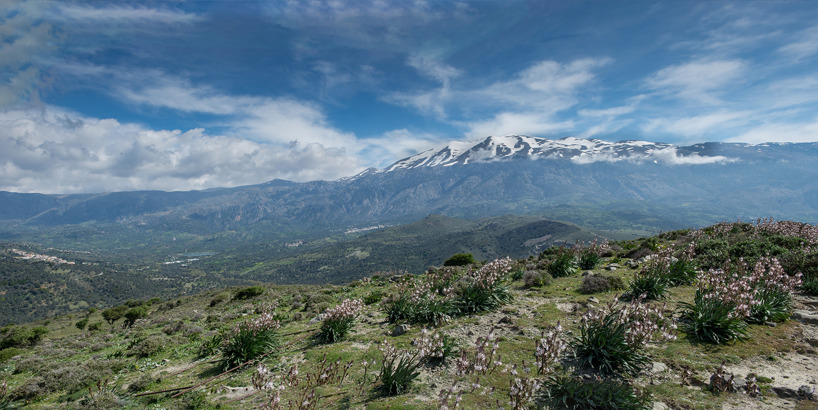 We had beautiful views in many places. Here from site 3 across the valley below and with Mount Ida in the background.
We had beautiful views in many places. Here from site 3 across the valley below and with Mount Ida in the background.
About 5 km from the last site we made the next stop. Here we were at about 500m level and the landscape looked very dry and heavily affected by grazing. Almost no orchids were seen. But we had a very nice view of the valley below and towards the snow covered Mount Ida further afield.
Route 5 Site 4
After passing through the village of Hordaki we would drop down to about 200m from the 500m level, which meant a number of serpentine curves before we were down in the valley where the Platis Potamos river flows. However, we continued up the other side to the city of Agios Ioannis one hundred meters higher up. Just after the village in the first left turn was site 4. Here the landscape was much more fertile with green meadows and olive trees. The site consisted of slopes to the right of the road with short vegetation and thorny bushes. Orchid rich area.
Species found:
Anacamptis boryi Ophrys cretica subsp. cretica
Anacamptis boryi var. alba Ophrys fusca subsp. creticola
Anacamptis collina Ophrys heldreichii
Anacamptis papilionacea subsp. alibertis Ophrys sicula
Himantoglossum robertianum Orchis anatolica subsp. sitiaca
Neotinea lactea Orchis italica
Neotinea tridentata Serapias bergonii
Ophrys bombyliflora Serapias lingua
Ophrys cinereophila Serapias parviflora
Ophrys cretica subsp. ariadnae
Route 5 Site 5
About 1.4 km from site 4 towards Nithafri there was a small church on the left side. Here we took our lunch sitting on suitable benches outside the church.
The landscape here was quite poor and there were not many orchids found either.
Species found:
Anacamptis collina
Anacamptis papilionacea subsp. heroica
Himantoglossum robertianum
Ophrys sicula
Ophrys tenthredinifera subsp. dictynnae
Orchis italica
Serapias parviflora
Route 5 Site Grigoria
We now chose the option to go to Grigoria and therefore dropped off the sites 6 and 7, hoping to find the endemic Ophrys spruneri subsp. grigoriana.
We therefore drove to Nithafri and onwards through the villages Apodpoulou, Vathiako, Platanos, Ardaktos, Lochria, Kamares to Grigoria, a distance of about 20 km. We continued straight through Grigoria toward the next town, Magarikari, but after a few hundred meters we turned right into a smaller road and after another few hundred meters on this we pulled one more turn to the right (westward). The site was the slopes to the left of this road. Bushy phrygana. The sought-after Ophrys was not difficult to find, because less than five meters from the car under some bushes stood several plants with its impressive large flowers, some of the largest ones seen in the genus Ophrys.
Species found:
Anacamptis collina
Anacamptis papilionacea subsp. alibertis
Himantoglossum robertianum
Ophrys bombyliflora
Ophrys cretica subsp. ariadnae
Ophrys cretica subsp. cretica
Ophrys heldreichii
Ophrys omegaifera subsp. basilissa
Ophrys omegaifera subsp. omegaifera
Ophrys sicula
Ophrys sphegodes subsp. cretensis
Ophrys spruneri subsp. grigoriana
Ophrys spruneri subsp. spruneri
Ophrys tenthredinifera subsp. dictynnae
Orchis italica
Orchis quadripunctata
Orchis quadripunctata var. alba
Orchis simia
Orchis simia x italica
The trip back to the hotel went through Agia Galini where we just before the city came into the main road to Rethymnon which we then followed up to Spili and there we turned towards Gerakari.
Route 1: Mount Idas (Psiloritis) western slopes about 68 km
For today's excursion we had chosen route number 1 of the winter's planned routes. It led us along the western slope of Crete's highest mountain, Mount Ida. According to a straight line we passed only a few kilometers from the highest peak, 2456 m. Most of the day we drove at levels 400-500 m.
We started the day driving north in order to reach the eastern road that runs from Rethymnon south to Agia Galini. We passed the villages Meronas, Agia Fotini and Thronos before reaching this road after about 11 km. Getting through the villages did not cause problems, it was straight ahead all the time. Some km after Thronos we reached the bigger road and turned south.
Even along this road we passed a number of villages, the larger ones were Vistagi, Platania, Fourfouras and Kouroutes. The last site was shortly after the last mentioned heading towards Nithafri.
Route 1 Site 1
After entering Rethymnon - Agia Galini road and passing Vistagi with about 3 km, we arrived to the first stop for the day. The slopes to the left, which were site 1, were bushy and quite difficult to access. The track, that went into the area, led only some 50 meters, then it was stop. Anyhow we saw some species at the roadside.
Species found:
Ophrys cretica subsp. cretica
Ophrys heldreichii
Orchis italica
Orchis quadripunctata
Route 1 Site 2
After about 1.5 km there was a hill to the right and here was site 2. Phrygana and bushes. Species rich area.
Species found:
Anacamptis collina Ophrys iricolor subsp. iricolor
Anacamptis pyramidalis Ophrys omagaifera subsp. omegaifera
Himantoglossum robertianum Ophrys sicula
Ophrys creberrima Ophrys sphegodes subsp.cretensis
Ophrys cretica subsp. cretica Ophrys tenthredinifera subsp. dictynnae
Ophrys fusca subsp. cressa Orchis italica
Ophrys heldreichii Orchis quadripunctata
Route 1 Site 3
From site 2 we continued about 2.4 km. Here we got parking space for the cars at the roadside next to an olive grove to the left. The morning sun gleamed into the olive grove and gave a almost "paradise" impression. It did not get worse that there were large amounts of orchids under the olive trees. Just above the olive grove there was a moisture path with a lot of Orchis laxiflora.
Here in this lovely greenery, we also took our lunch before continuing.
Species found:
Anacamptis collina
Anacamptis laxiflora
Anacamptis papilionacea subsp. heroica
Ophrys cretica subsp. ariadnae
Ophrys cretica subsp. cretica
Ophrys heldreichii
Ophrys phryganae
Ophrys sicula
Ophrys sphegodes subsp.cretensis
Orchis italica
Orchis pauciflora
Orchis simia
Serapias bergonii
Serapias lingua
Route 1 Site 4
After driving through the next town, Fourfouras, we stopped at site 4. From the 3rd, it was about 3.8 km. Open area with only single small trees, phrygana. Orchid rich.
Species found:
Anacamptis collina
Anacamptis papilionacea subsp. alibertis
Himantoglossum robertianum
Neotinea lactea
Ophrys bombyliflora
Ophrys bombyliflora x tenthredinifera subsp. dictynnae
Ophrys cinereophila
Ophrys cretica subsp. cretica
Ophrys heldreichii
Ophrys phryganae
Ophrys sicula
Orchis italica
Route 1 Site 5
The day's last stop was made about 4.7 km further on. We had passed the village of Kouroutes and immediately after a left turn there was a track right up through a hillock. Here it was possible to park the cars. Also here were the tall fences that were difficult to get over.
Species found:
Anacamptis collina Ophrys omegaifera subsp. omegaifera
Himantoglossum robertianum Ophrys sphegodes subsp. cretensis
Ophrys cretica subsp. cretica Orchis italica
Ophrys heldreichii Orchis quadripunctata
Ophrys iricolor subsp. iricolor Serapias bergonii
The trip back to the hotel went same way that we used during the day and we arrived at the hotel shortly after half past five.
Monday 10 April 2017
Route 2: Crete south – Saktouria about 68 km
The last of our routes became the one who took us farthest south during the week. Slightly cloudy but otherwise a nice summer day, measured with Swedish measurements. As usual we started the day driving to Spili and further south toward Agia Galini. About 14 km south of Spili we left to the right towards Saktouria / Melampes. Then we spent the day along this road down to the village of Saktouria. The road was here at levels from 350 to about 500 m up at the village. This trip also gave opportunities for many beautiful views. The first site was just after we left the main road. An attempt was made to find site 8 from the preplanned route, which was further along the highway beyond the crossroad, but it did not seem to be any good areas so we turned back again and continued down the road to Saktouria. Another site was also dropped, site 6. It seemed very difficult to get through the village to the site with 5 cars, so we chose to give up the attempt. After site 4 we chose to drive down to the village and the last site, site 7. Site 5 therefore became the last site of our journey. Here we might also got the biggest surprise during our trip, a land-living crab. Rare in the Eastern Mediterranean there is a freshwater crab that is partly land-living, Potamon potamos.
Route 2 Site 1
Today's first planned stop was right after that we turned off from Rethymnon - Ag. Galini road. About 100m before the signs that pointed right towards Saktouria went a road to the right (probably part of an old road stretch). About 50m into this there was a dirt road to the right going around a hill. Interesting site. here we once again found the big variant of Ophrys spruneri, subsp. grigoriana.
Species found:
Anacamptis collina
Anacamptis pyramidalis
Himantoglossum robertianum
Neotinea lactea
Neotinea tridentata
Ophrys bombyliflora
Ophrys cinereophila
Ophrys cretica subsp. cretica
Ophrys episcopalis
Ophrys heldreichii
Ophrys heldreichii x dictynnae
Ophrys iricolor subsp. iricolor
Ophrys sicula
Ophrys sphegodes subsp. cretensis
Ophrys spruneri subsp. spruneri
Ophrys spruneri subsp. grigoriana
Orchis italica
Orchis quadripunctata
Serapias orientalis
Route 2 Site 2
The next stop was made about 700 m further. Here in a serpentine curve there was a gravel road on the right. The site referred to the slopes to the left of the gravel road.
Species found:
Anacamptis collina
Anacamptis papilionacea subsp. heroica
Anacamptis pyramidalis
Himantoglossum robertianum
Neotinea lactea
Ophrys creberrima
Ophrys cretica subsp. cretica
Ophrys omegaifera subsp. basilissa
Ophrys sicula
Orchis italica
Orchis quadripunctata
Serapias bergonii
Route 2 Site 3
About 600 m further there was a crossroads where we turned right towards Saktouria. Site 3 was another 500m forward after the crossing. Slopes down from the road.
Species found:
Anacamptis boryi Ophrys cretica subsp. cretica
Anacamptis collina Ophrys episcopalis
Anacamptis papilionacea subsp. heroica Ophrys heldreichii
Anacamptis papilionacea subsp. alibertis var. alba Ophrys sicula
Himantoglossum robertianum Ophrys tenthredinifera subsp. dictynnae
Neotinea lactea Orchis italica
Ophrys bombyliflora Orchis pauciflora
Ophrys creberrima Serapias orientalis
Route 2 Site 4
Stop 4 was about 1.6 km from last stop. Here there was space for the cars right after a sharp right-hand curve. The site was the slopes to the left of the road. But we first took our "lunchbasket" from the hotel before we searched the area.
Species found:
Anacamptis collina
Anacamptis papilionacea subsp. heroica
Himantoglossum robertianum
Ophrys cinereophila
Ophrys creberrima
Ophrys cretica subsp. cretica
Ophrys episcopalis
Ophrys omegaifera subsp. basilissa
Ophrys omegaifera subsp. omegaifera
Ophrys phryganae
Ophrys sphegodes subsp. cretensis
Ophrys spruneri subsp. spruneri
Ophrys tenthredinifera subsp. dictynnae
Orchis italica
Orchis pauciflora
Orchis quadripunctata
Serapias orientalis
Route 2 Site 7
To be sure to reach Saktouria, we now chose to drive down to the village and site 7. We just passed the outskirts of the village and immediately after this we reached the site. Parking could be done where the road divided. Rather steep slopes to the left of the road. But already at the roadside we found ssp.grigoriana for the third time.
Species found:
Anacamptis boryi
Anacamptis collina
Anacamptis papilionacea subsp. heroica
Himantoglossum robertianum
Ophrys cretica subsp. ariadnae
Ophrys cretica subsp. cretica
Ophrys episcopalis
Ophrys omegaifera subsp. omegaifera
Ophrys sicula
Ophrys spruneri subsp. grigoriana
Orchis pauciflora
Orchis quadripunctata
Route 2 Site 5
As mentioned above, we dropped site 6 and proceeded to site 5. Since this became the last site of our journey, it was nice that the site was orchids rich, especially the slopes below the road. Here we also got a real surprise when we found a living crab, kilometers from the nearest water. Later investigation, back home, showed that this was a freshwater crab that partly lives on land, a very rare species from the eastern Mediterranean. Probably water ran into the dikes during winter but at the time for our visit, no water was seen as far as we could see.
Species found:
Anacamptis collina
Himantoglossum robertianum
Ophrys bombyliflora
Ophrys cinerophila
Ophrys creberrima
Ophrys cretica subsp. ariadnae
Ophrys cretica subsp. cretica
Ophrys episcopalis
Ophrys omegaifera subsp. omegaifera
Ophrys phryganae
Ophrys sicula
Ophrys tenthredinifera subsp. dictynnae
Orchis italica
Orchis quadripunctata
Orchis quadripunctata var. alba
Serapias bergonii
After site 5, we set our course the shortest way back home, i.e. same way as we arrived during the day. We reached the hotel just before five o’clock, giving us some time to start packing for our home journey tomorrow, before it was time for our last dinner together.
The list below shows which species / hybrids we found during our week
01. Anacamptis boryi
Anacamptis boryi var. alba
02. Anacamptis collina
03. Anacamptis coriophora subsp. fragrans, bud
04. Anacamptis laxiflora
05. Anacamptis papilionacea subsp. alibertis
Anacamptis papilionacea subsp. alibertis var. alba
06. Anacamptis papilionacea subsp. heroica
07. Anacamptis pyramidalis
08. Himantoglossum robertianum
09. Neotinea lactea
Neotinea lactea var. alba
10. Neotinea tridentata
11. Ophrys bombyliflora
12. Ophrys cinereophila
13. Ophrys creberrima
14. Ophrys cretica subsp. ariadnae
15. Ophrys cretica subsp. cretica
16. Ophrys episcopalis
17. Ophrys fusca subsp. cressa
18. Ophrys fusca subsp. creticola
19. Ophrys heldreichii
20. Ophrys iricolor subsp. iricolor
21. Ophrys omegaifera subsp. basilissa
22. Ophrys omegaifera subsp. omegaifera
23. Ophrys phryganae
24. Ophrys sicula
25. Ophrys sphegodes subsp. cretensis
Ophrys sphegodes subsp. cretensis var. alba
26. Ophrys spruneri subsp. grigoriana
27. Ophrys spruneri subsp. spruneri
28. Ophrys tenthredinifera subsp.dictynnae
29. Ophrys tenthredinifera subsp. dimidiata
30. Orchis anatolica subsp. anatolica ?
31. Orchis anatolica subsp. sitiaca
32. Orchis anthropophora
33. Orchis italica
Orchis italica var. alba
34. Orchis pauciflora
35. Orchis quadripunctata
Orchis quadripunctata var. alba
36. Orchis simia
37. Serapias bergonii
38. Serapias lingua
39. Serapias orientalis
40. Serapias parviflora
The following four hybrids were seen
Anacamptis boryi x papilionacea sp.
Ophrys bombyliflora x tenthredinifera subsp. dictynnae
Ophrys heldreichii x tenthredinifera subsp. dictynnae
Orchis italica x simia
